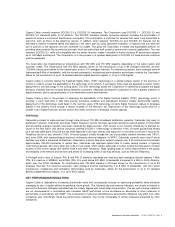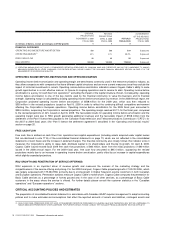Cogeco 2009 Annual Report Download - page 20
Download and view the complete annual report
Please find page 20 of the 2009 Cogeco annual report below. You can navigate through the pages in the report by either clicking on the pages listed below, or by using the keyword search tool below to find specific information within the annual report. Management’s discussion and analysis COGECO CABLE INC. 2009 19
(“Videotron”), an indirect subsidiary of Quebecor Inc., offers competitive telecommunications services in Cogeco Cable’s Québec
footprint and its new wholly-owned advanced wireless service (“AWS”) is expected to be rolled out soon. Cogeco Cable also
competes with other telecommunications service providers, including Vonage, Primus and Rogers Home Phone (formerly known as
Sprint), with alternative service providers that use resale or third-party access arrangements in effect, and with smaller facilities-
based competitors such as Maskatel in certain local markets within its network footprint. It is anticipated that other AWS service
providers will launch new wireless voice, HSI, data and video services in the near future within Cogeco Cable’s footprint, thus
resulting in increased competition for the fixed Telephony, HSI, data and Television services of Cogeco Cable.
In Portugal, Cogeco Cable’s indirect subsidiary Cabovisão faces competition for all its lines of business mainly from incumbent
telecommunications carrier Portugal Telecom, SGPS, S.A. (“PT”), Zon Multimedia, SGPS, S.A. (“Zon”), Vodafone, as well as from
Sonaecom, SGPS, S.A. (“Sonaecom”), a subsidiary of diversified Portuguese conglomerate Sonae, SGPS, S.A. (“Sonae”). Zon
owns TV Cabo, the largest cable telecommunications operator in Portugal, and also offers a direct-to-home satellite distribution
service to the Portuguese market. Zon’s cable plant overlaps the major part of Cabovisão’s footprint in Portugal. Zon also owns
extensive program content interests, including equity interests in several pay television channels distributed by Cabovisão. PT’s
national telephone network, PT Communicações, which offers a full range of fixed and mobile telecommunications services
throughout Portugal, is aggressively pursuing the rollout of Meo, its competitive IPTV service over its wireline plant, and is offering
its own direct-to-home satellite service. In addition, PT has launched in Portugal a new digital terrestrial television service available
directly over-the-air. Sonaecom owns and operates the Clix (residential fixed telephony, HSI and IPTV), Novis (business telephony
solutions) and Optimus (wireless telephony and wireless HSI) services, which provide voice, data, HSI, video and mobile services to
the residential and business markets. Vodafone recently launched its own video distribution service for bundling with its mobile
telephone and Internet services. Cabovisão, Zon, PT, Sonaecom, Vodafone and AR Telecom all have competitive triple-play offers
available in the Portuguese market. Cabovisão is aggressively pursuing the rollout of its Digital Television services, which include
HD channels, throughout its footprint, but it remains less penetrated than that of its main competitors. Cabovisão intends to
eventually launch a VOD service on its digital platform, and thus be able to compete with the other VOD service offerings available
in the Portuguese market. While Cabovisão and Zon continue to carry a number of legacy video services on less bandwidth-efficient
analog channels, the competitive television service offerings of the other competitors in the Portuguese market are all Digital. PT,
Zon and Vodafone each have a significantly larger overall customer base, and both Zon and PT have a larger video customer base,
than Cabovisão. Several competitors in the Portuguese market have announced that they are deploying fiber facilities to the
premises of customers.
Cogeco Cable’s footprint includes certain regions in Ontario (Burlington and Windsor) and in Portugal (Palmela) where the
automobile industry is a significant driver of economic activity. The sharp downturn experienced by the automobile industry in fiscal
2009 may have an adverse impact on the level of economic activity and consumer expenditures on goods and services within those
communities. In previous recessionary periods, demand for cable telecommunications services has generally proven to be resilient.
However, there is no assurance that demand will remain resilient in a prolonged global recession.
The level of piracy of television signals and the actual penetration of illicit reception of television distribution services in households
within the Corporation’s service areas may also have a significant effect on the Corporation’s business and the competitiveness of
its service offerings.
TECHNOLOGICAL RISKS
The rapid evolution of telecommunications technologies is fuelled by a highly competitive global market for digital content, consumer
electronics and broadband products and services. The Corporation continues to monitor the development of technologies used for
the transmission, distribution, reception and storage of data and their deployment by various existing or potential competitors in the
broadband telecommunications markets.
There are now several terrestrial and satellite transmission technologies available to deliver a range of electronic communications
services to homes and to commercial establishments with varying degrees of flexibility and efficiencies, and thus compete with cable
telecommunications. On the other hand, cable telecommunications also continue to benefit from rapid improvements, particularly in
the areas of modulation, digital compression, fractioning of optoelectronic links, multiplexing, HD distribution and switched video
distribution.
Management of the Corporation believes that broadband wireline distribution over fibre and coaxial cable continues to be an
efficient, reliable, economical and competitive platform for the distribution of a full range of electronic communications products and
services. However, competitive market forces drive the further deployment of fiber optic facilities right up to the user premises, both
for business and residential customers. The competitiveness of the cable broadband telecommunications platform will therefore
continue to require substantial additional capital investment on a timely basis in an increasingly competitive and uncertain market
environment.
























